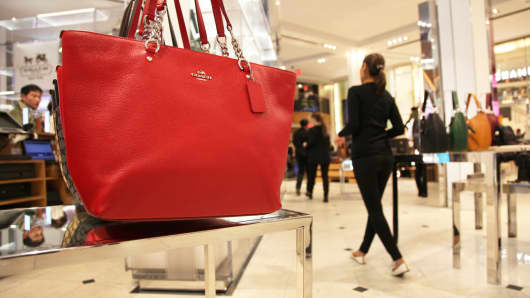Coach shares shot nearly 10 percent higher on Tuesday, after the handbag maker reported its first sales increase in more than two years.
But while trends at the leather goods company continued to improve during the second quarter, the results weren’t quite as impressive as they appeared on the surface.
For one, although the company’s revenues increased 4 percent from the prior-year period, the gain was mostly attributable to its Stuart Weitzman brand. The footwear label, which Coach acquired in May, contributed $94 million in sales during the quarter. By comparison, North America sales for the Coach brand sank 7 percent, to $731 million.
Second, although the company’s domestic same-store sales logged another quarter of improvement, they still declined 4 percent. That’s despite the fact the brand was up against a 22 percent decrease in the year-ago period.
Overall, Coach’s sales are down $200 million over the past two years, as it continues to lose market share in the already weak handbag category.
“As much as a return to positive territory is to be welcomed, looking under the hood reveals a set of numbers that are still far from being finely tuned,” said Hakon Helgesen, retail analyst at Conlumino research firm.
In addition to its internal challenges, Coach is challenged by softness in the overall handbag market.
On the company’s earnings call, CEO Victor Luis indicated that revenues from the overall category were roughly flat during the quarter, compared with low-single-digit growth in the previous period. He attributed that decline to promotional activity, which drove down the average price.
What’s more, Michael Kors’ management said in November that the popularity of smaller, less expensive handbags was contributing to softness in the market.
A slowdown in sales at department stores also continues to weigh on the handbag category, with total revenues at those locations dropping 2 percent in 2015. This is likely to have a bigger impact on Kors than Coach, as its sales are more heavily skewed toward department stores.
Though Coach still has plenty of ground to cover, it has nonetheless made strides in its efforts to shed its reputation as a mass brand. By expanding its reach into select higher-price offerings, including its luxury 1941 label, Coach will soon be sold in high-end stores that haven’t traditionally offered its brand, including Nordstrom and Saks.
The company has also shifted away from its ubiquitous logo bags, which now make up less than 5 percent of its sales at Coach-branded retail shops in North America, and less than 30 percent at its outlet locations. Meanwhile, it has pulled back on the number of online sales it offers during each quarter.
What’s more, its redesigned stores — which are expected to make up 40 percent of its fleet by the end of the fiscal year in June — continue to outperform the others.
As a result, management reiterated its forecast that the brand will post positive domestic comparable sales during the fourth quarter. That would be the first time it’s done so in more than three years.
“The key takeaway following the [second-quarter] print is that the turnaround at Coach continues,” said Jefferies analyst Randal Konik, who has a “buy” rating and $51 price target on the brand.
The stock closed near $33. Despite the day’s gains, Coach shares are down more than 9 percent over the past year.
[“source -pcworld”]







